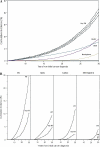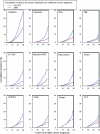Subsequent neoplasms in 5-year survivors of childhood cancer: the Childhood Cancer Survivor Study
- PMID: 20634481
- PMCID: PMC2907408
- DOI: 10.1093/jnci/djq238
Subsequent neoplasms in 5-year survivors of childhood cancer: the Childhood Cancer Survivor Study
Abstract
Background: The occurrence of subsequent neoplasms has direct impact on the quantity and quality of life in cancer survivors. We have expanded our analysis of these events in the Childhood Cancer Survivor Study (CCSS) to better understand the occurrence of these events as the survivor population ages.
Methods: The incidence of and risk for subsequent neoplasms occurring 5 years or more after the childhood cancer diagnosis were determined among 14,359 5-year survivors in the CCSS who were treated from 1970 through 1986 and who were at a median age of 30 years (range = 5-56 years) for this analysis. At 30 years after childhood cancer diagnosis, we calculated cumulative incidence at 30 years of subsequent neoplasms and calculated standardized incidence ratios (SIRs), excess absolute risks (EARs) for invasive second malignant neoplasms, and relative risks for subsequent neoplasms by use of multivariable Poisson regression.
Results: Among 14,359 5-year survivors, 1402 subsequently developed 2703 neoplasms. Cumulative incidence at 30 years after the childhood cancer diagnosis was 20.5% (95% confidence interval [CI] = 19.1% to 21.8%) for all subsequent neoplasms, 7.9% (95% CI = 7.2% to 8.5%) for second malignant neoplasms (excluding nonmelanoma skin cancer), 9.1% (95% CI = 8.1% to 10.1%) for nonmelanoma skin cancer, and 3.1% (95% CI = 2.5% to 3.8%) for meningioma. Excess risk was evident for all primary diagnoses (EAR = 2.6 per 1000 person-years, 95% CI = 2.4 to 2.9 per 1000 person-years; SIR = 6.0, 95% CI = 5.5 to 6.4), with the highest being for Hodgkin lymphoma (SIR = 8.7, 95% CI = 7.7 to 9.8) and Ewing sarcoma (SIR = 8.5, 95% CI = 6.2 to 11.7). In the Poisson multivariable analysis, female sex, older age at diagnosis, earlier treatment era, diagnosis of Hodgkin lymphoma, and treatment with radiation therapy were associated with increased risk of subsequent neoplasm.
Conclusions: As childhood cancer survivors progress through adulthood, risk of subsequent neoplasms increases. Patients surviving Hodgkin lymphoma are at greatest risk. There is no evidence of risk reduction with increasing duration of follow-up.
Figures


Comment in
-
Genetic factors contribute to subsequent neoplasms in survivors of childhood cancer.CA Cancer J Clin. 2020 May;70(3):143-144. doi: 10.3322/caac.21603. Epub 2020 Apr 2. CA Cancer J Clin. 2020. PMID: 32239755 No abstract available.
References
-
- Ries LA, Eisner MP, Kosary CL, et al. SEER. In: Krapcho M, Neyman N, Aminou R, Waidron W, Ruhl J, Howlader N, Tatalovich Z, Cho H, Mariotto A, Eisner MP, Lewis DR, Cronin K, Chen HS, Feuer EJ, Stinchcomb DG, Edwards BK, editors. Cancer Statistics Review 1975–2003. Bethesda, MD: National Cancer Institute; http://seer.cancer.gov/csr/1975_2007. Accessed July 8, 2010.
-
- Bhatia S, Yasui Y, Robison LL, et al. High risk of subsequent neoplasms continues with extended follow-up of childhood Hodgkin's disease: report from the Late Effects Study Group. J Clin Oncol. 2003;21(23):4386–4394. - PubMed
-
- Neglia JP, Friedman DL, Yasui Y, et al. Second malignant neoplasms in five-year survivors of childhood cancer: childhood cancer survivor study. J Natl Cancer Inst. 2001;93(8):618–629. - PubMed
-
- Garwicz S, Anderson H, Olsen JH, et al. Second malignant neoplasms after cancer in childhood and adolescence: a population-based case-control study in the 5 Nordic countries. The Nordic Society for Pediatric Hematology and Oncology. The Association of the Nordic Cancer Registries. Int J Cancer. 2000;88(4):672–678. - PubMed
-
- Bassal M, Mertens AC, Taylor L, et al. Risk of selected subsequent carcinomas in survivors of childhood cancer: a report from the Childhood Cancer Survivor Study. J Clin Oncol. 2006;24(3):476–483. - PubMed
Publication types
MeSH terms
Grants and funding
LinkOut - more resources
Full Text Sources
Other Literature Sources
Medical
Research Materials

